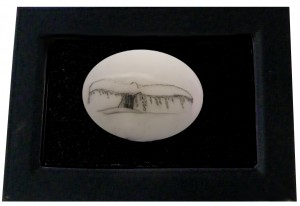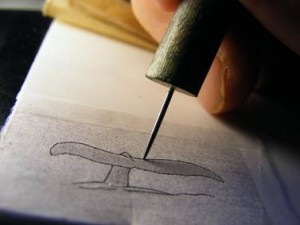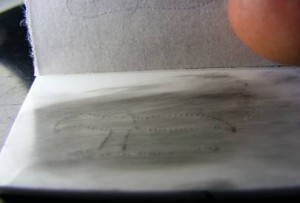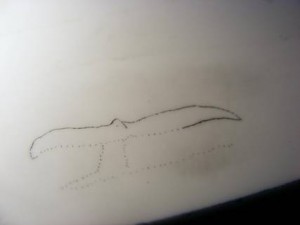Scrimshaw – Quick to Learn, A Lifetime to Master
 We are including an excerpt from Chapter 5 of “Scrimshaw? But I Can’t Draw!” so you can start learning how to scrimshaw on any hard surface, including mammoth ivory, old piano keys, corian, acrylic – even a light switch cover!
We are including an excerpt from Chapter 5 of “Scrimshaw? But I Can’t Draw!” so you can start learning how to scrimshaw on any hard surface, including mammoth ivory, old piano keys, corian, acrylic – even a light switch cover!
——-
You are going to learn one of several ways to transfer your artwork to your ivory or material of choice:
First things first:
- You need your materials and your tools, including your scribe, a bright light, and some type of magnification
- You need your ink or oil paint and rags
- You need your eye protection and your dust mask (if you’re sanding down anything)
- You need your Bees Wax
or Renaissance Wax
- You need your computer (or a copier that can reduce your picture/project of choice
- And, Scotch tape
First, measure the piece you’re going to scribe, then create an image about ⅛” smaller all around, using your computer and a laser printer or an inkjet printer. Many copiers will reduce images as well. You won’t want your image to reach the edge, though you can get close. If you are working with an oval, use your computer to draw an oval around the piece as well, so you will know that it is centered.
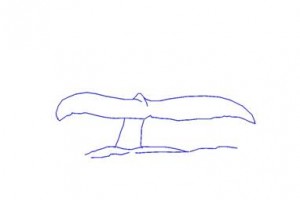
With this technique you will be copying the old whaleman’s way of creating scrimshaw. .
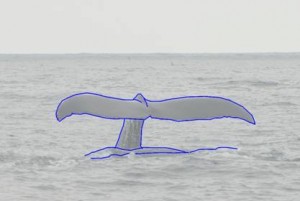
Cut out a copy of the image you want to scrimshaw and leave ½” to 1” on all of the sides. Carefully secure your material to your work surface, then secure the print over the top of your material, taping it so it will not shift as you move your work surface. Be sure your work is aligned properly!
I worked on a piece in 2010 for the Williamsburg Congregational Church’s annual craft fair, and once I’d finished the main work, found that I was about ten degrees off, as shown on the picture above. Looks like it’s going down a hill! I kept this old one as a reminder to myself (shown at the beginning of the chapter), re-scrimshawed the church on a new piece of ivory after aligning the work properly. They raffled it off, and it drew quite a bit of interest.
Press the point in as vertically as possible. This will create the most consistent dot, an angled dot’s ink will wipe out of the indentation more or less, depending on the angle and the angle you wipe away the excess with, where a vertical dot will remain consistent.
You will want to pierce the paper only along the prominent lines. This will be your “dot-to-dot” for creating your piece. Here, The whale fluke from the previous chapter has been outlined and the actual picture faded using “GIMP 2.8″ (similar to PhotoShop).
Pierce along the lines about every 1/32” (or 1mm) so you can visualize the fluke easily. You may want to add the horizon line as well.
Once you have finished creating the dots, remove the paper and inspect it under a bright light. You should be able to see the indentations and see where you are going to scribe your lines. Using a Q-Tip or a small brush, coat the ivory with ink or black oil paint and quickly wipe it off with a soft cloth (tissue may actually scratch it or leave lint, so the old t-shirt your spouse has been complaining about would be perfect!). The dots should be visible enough that you can now place it under your magnification and begin carefully scribing the lines.
Here, you are lightly scribing from one dot to the next. Scribe enough so you can see the line when you wipe ink or oil paint onto it, then right off again (I am using oil paint, my preference changed to oil paint after an interview with Bob Hergert).
Once you have finished scribing the lines, take a break, take a picture of it! Thanks to digital cameras, you can document your work every step of the way.
Tip – if you are “checking your work” by repeatedly coating your ivory with ink to see where you’ve been, wipe it off immediately – don’t let it dry and then burnish it off. Better yet, use a little bit of oil paint: it stays liquid longer and doesn’t dry to a hard finish for at least a week.
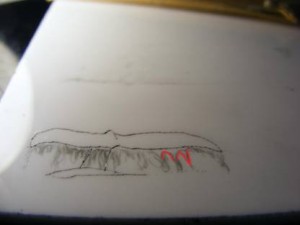 Now we come to decision time: Do you want to add the water dripping off the back of the fluke, even if you can’t draw? You can make “V” shapes and “\ /” shapes (open bottomed V’s), right? Using a very soft lead pencil or colored pencil (as long as it’s soft lead), you can draw the water flowing off the tail of the whale by making these shapes across the bottom of the tail, varying the width between them. Don’t worry, if you don’t like it, you can just wipe it off and start again. Once the open V’s are drawn on, you can close them by adding a “U” to the bottom of them, making them bulge slightly in the middle, and adding a drop or two shaped like the letter “o” below them. Use a pencil and see what you come up with either on your scrimshaw or on a separate piece of paper.
Now we come to decision time: Do you want to add the water dripping off the back of the fluke, even if you can’t draw? You can make “V” shapes and “\ /” shapes (open bottomed V’s), right? Using a very soft lead pencil or colored pencil (as long as it’s soft lead), you can draw the water flowing off the tail of the whale by making these shapes across the bottom of the tail, varying the width between them. Don’t worry, if you don’t like it, you can just wipe it off and start again. Once the open V’s are drawn on, you can close them by adding a “U” to the bottom of them, making them bulge slightly in the middle, and adding a drop or two shaped like the letter “o” below them. Use a pencil and see what you come up with either on your scrimshaw or on a separate piece of paper.
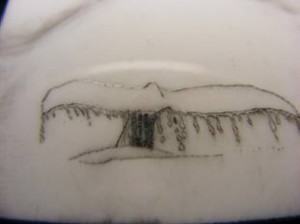
This concludes the excerpts from “Scrimshaw? But I Can’t Draw! Volume 1 – A Beginner’s Guide“
For more images, try “The Scrimshander’s Secret Scrapbook of Whaling Era Images“ available from Lulu.com!
TEMPLATE:
Whale Tale Template – Andrew Perkins – CC Jesse Wagstaff

